Charles E W Bean, Diaries, AWM38 3DRL 606/250/1 - 1917 - 1937 - Part 3
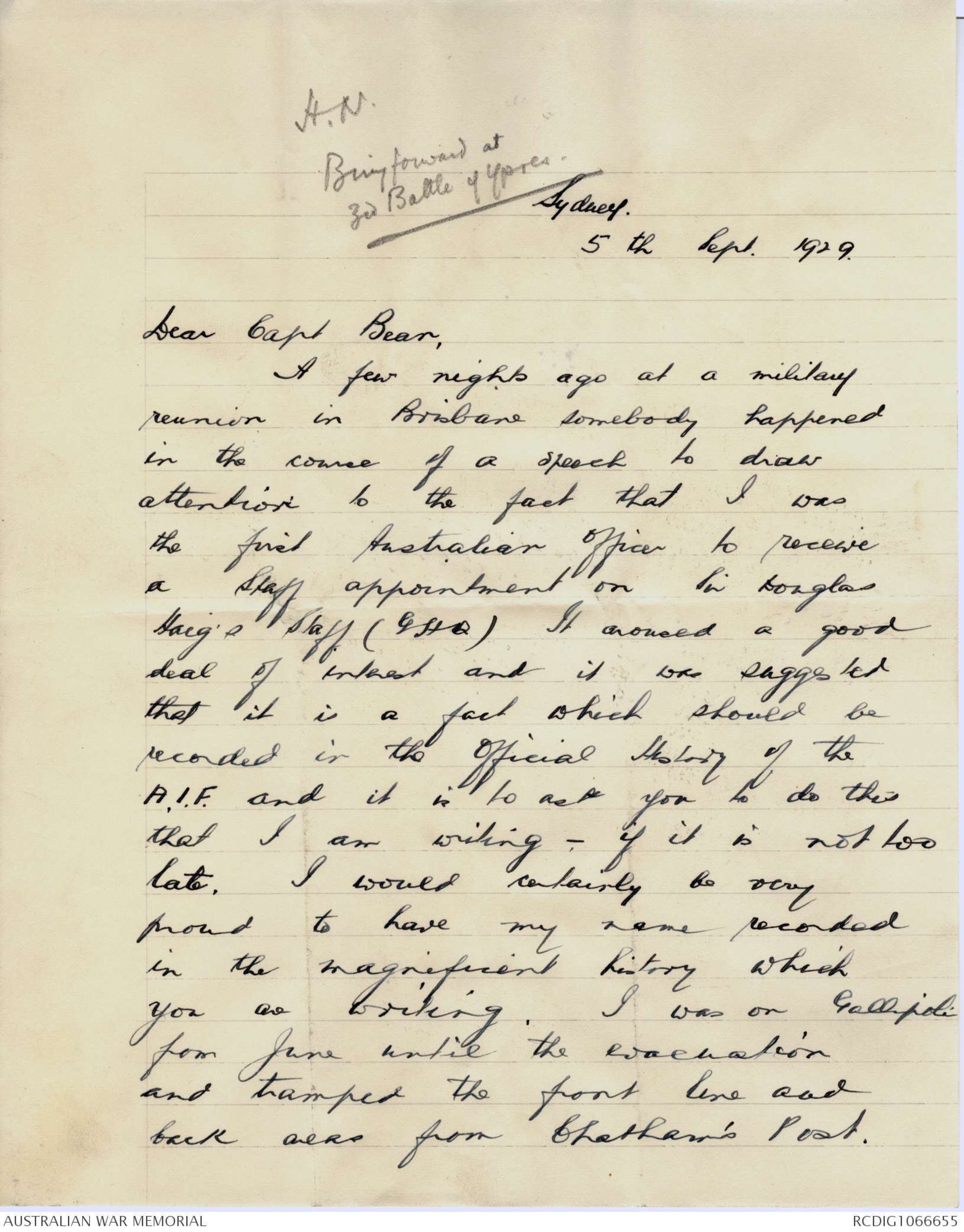
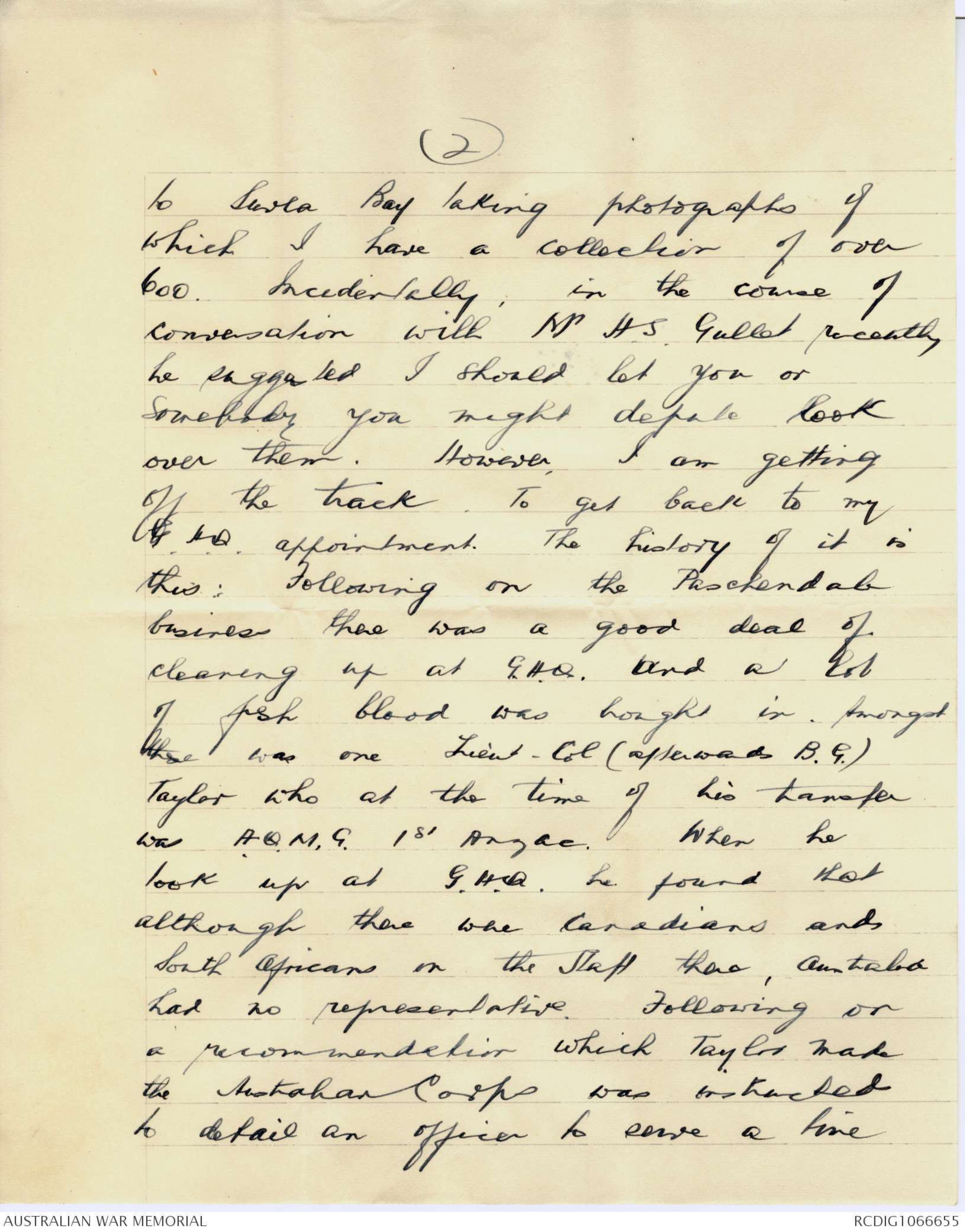
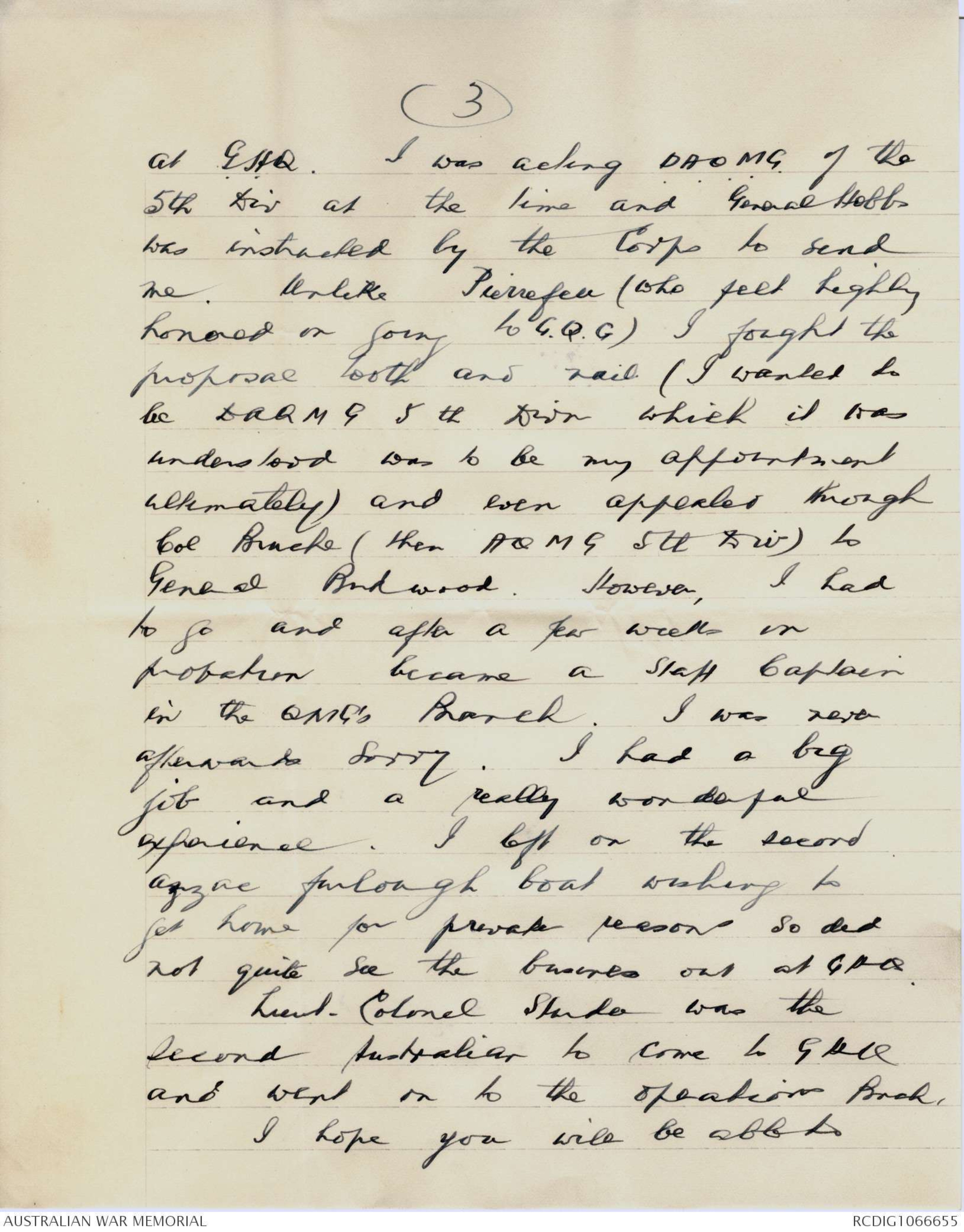
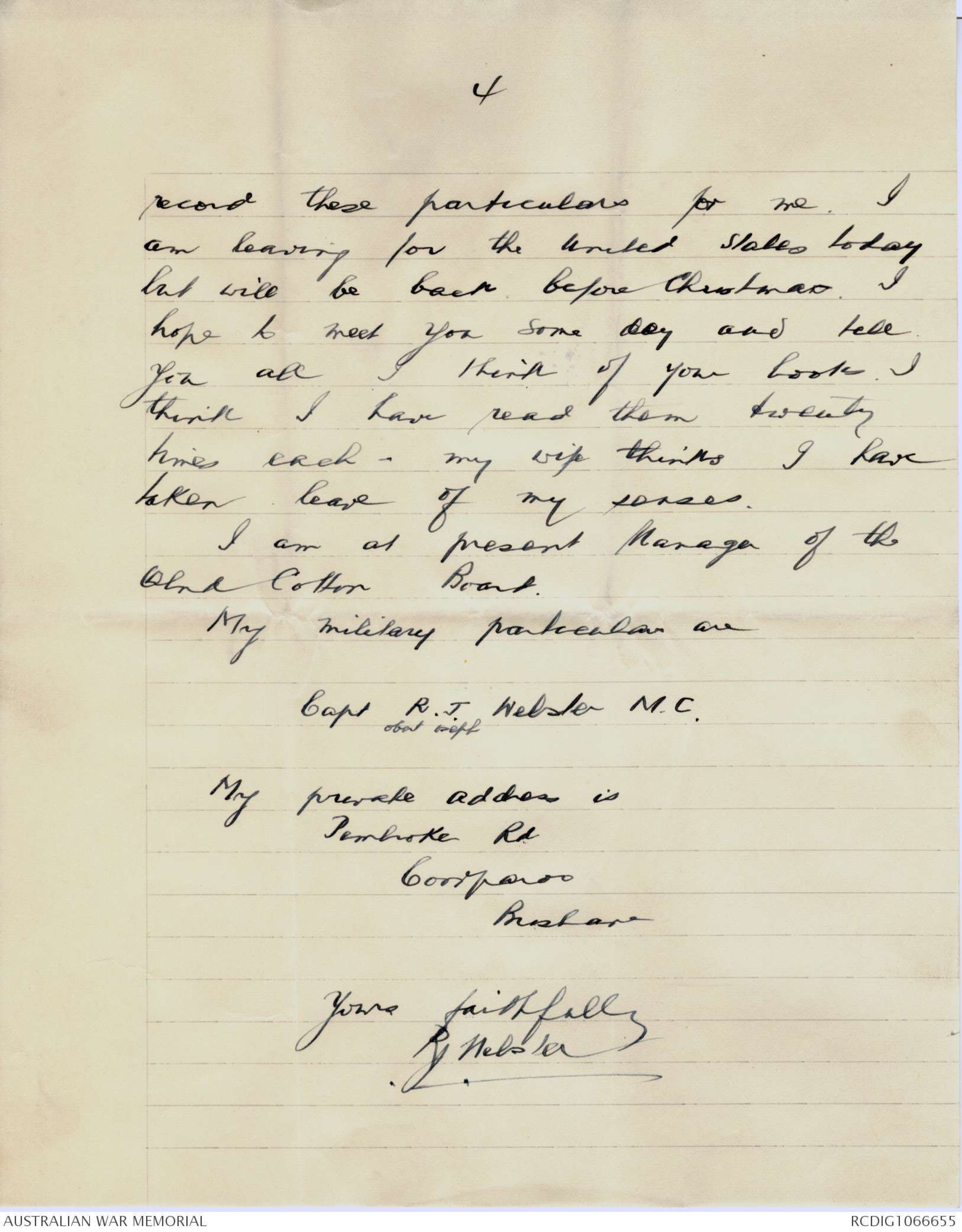


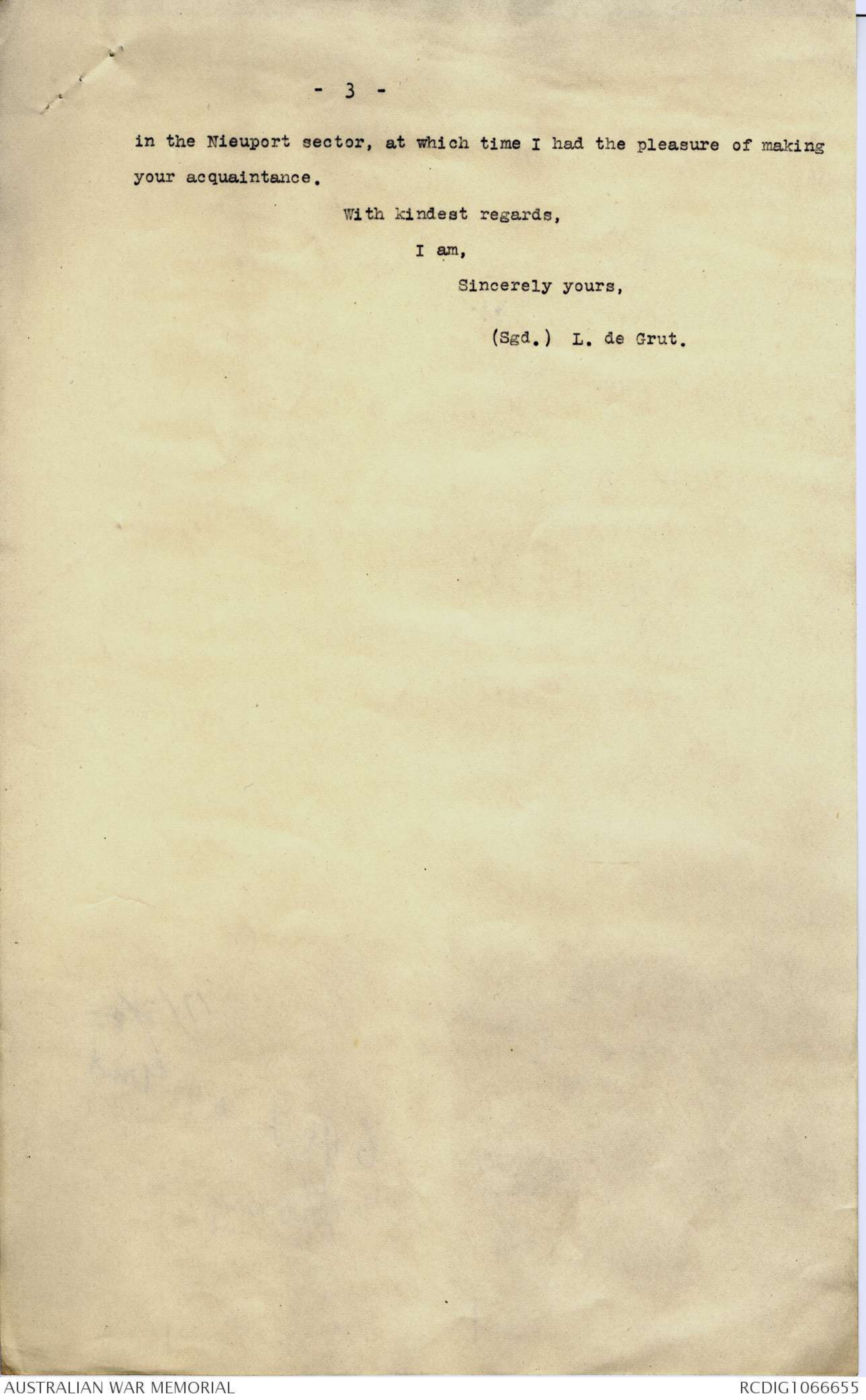
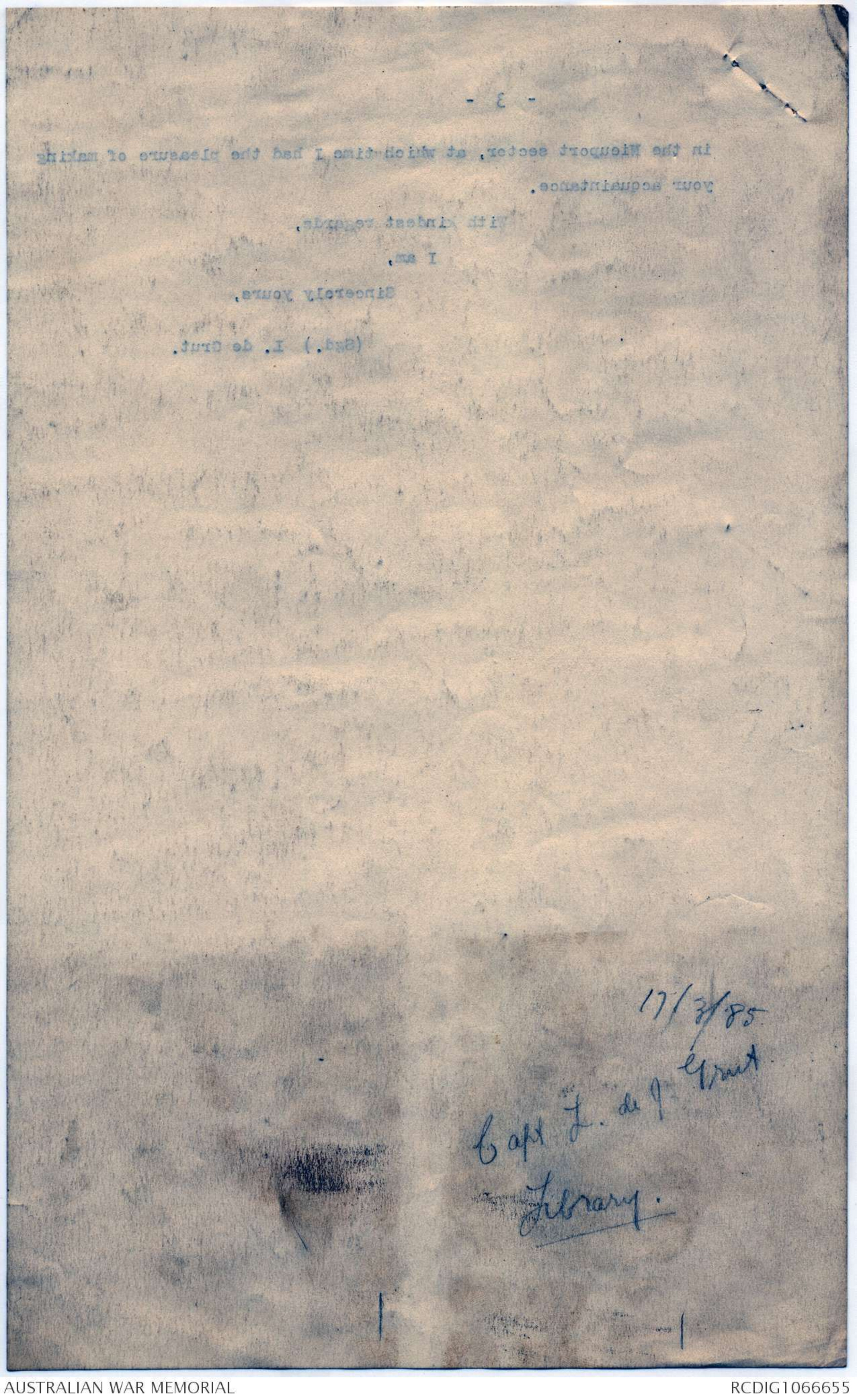
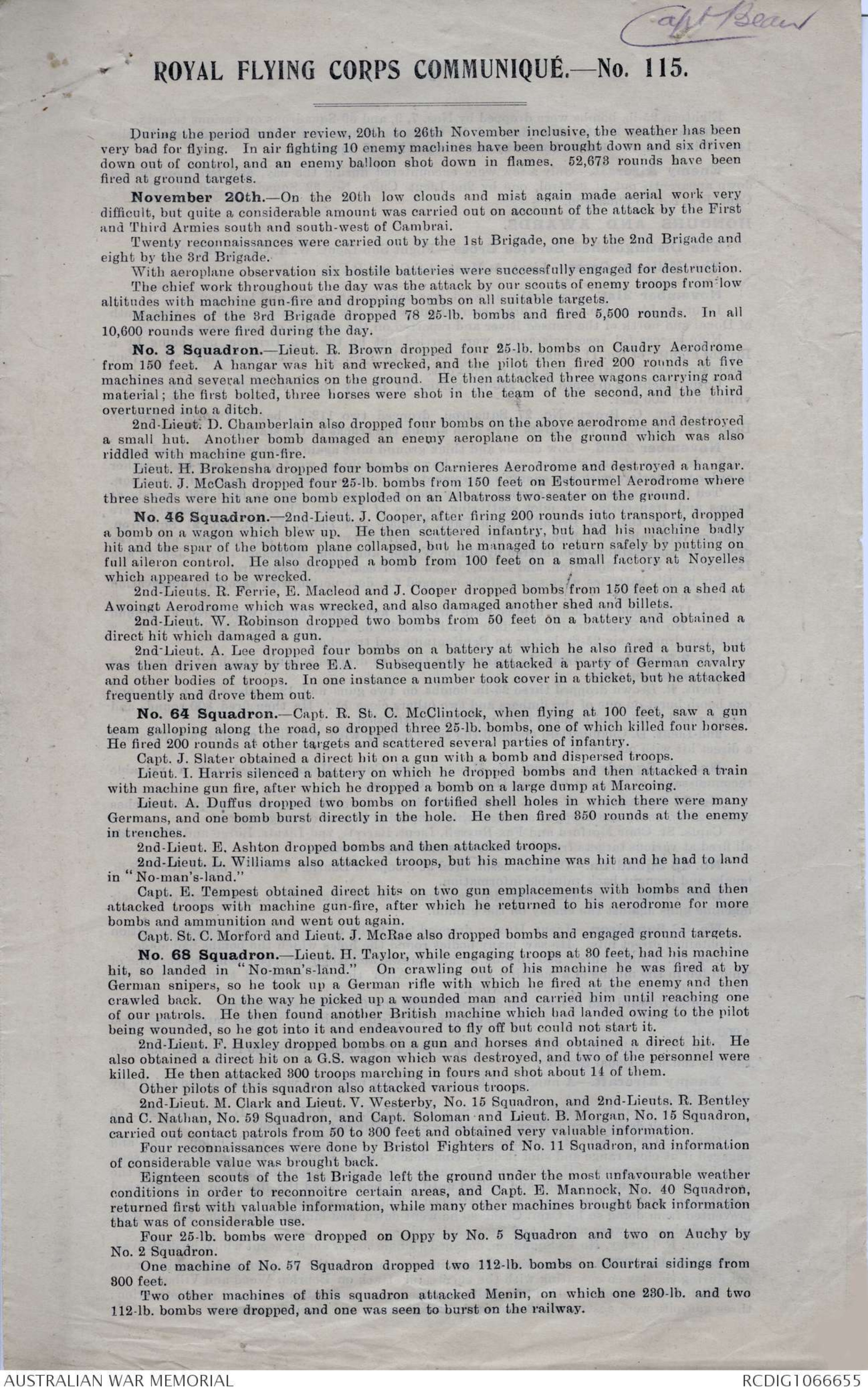
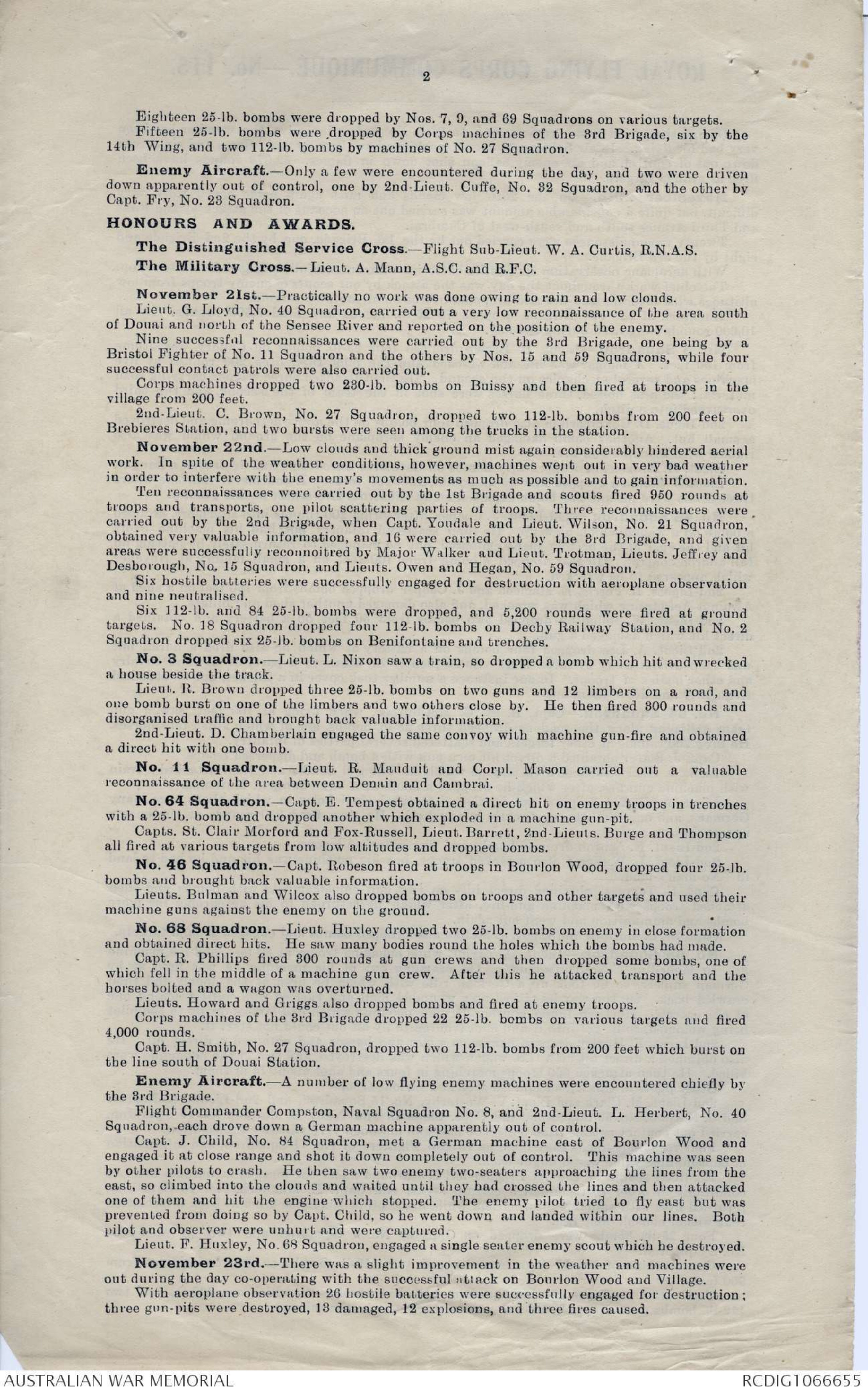
[*H.N.
Bring forward at
3rd Battle of Ypres.*]
Sydney.
5th Sept. 1929.
Dear Capt Bean,
A few nights ago at a military
reunion in Brisbane somebody happened
in the course of a speech to draw
attention to the fact that I was
the first Australian officer to receive
a Staff appointment on Sir Douglas
Haig's Staff (GHQ) It aroused a good
deal of interest and it was suggested
that it is a fact which should be
recorded in the Official History of the
A.I.F. and it is to ask you to do this
that I am writing - if it is not too
late. I would certainly be very
proud to have my name recorded
in the magnificent history which
you are writing. I was on Gallipoli
from June until the evacuation
and tramped the front line and
back areas from Chatham's Post.
(2)
to Suvla Bay taking photographs of
which I have a collection of over
600. Incidentally, in the course of
conversation with Mr H.S. Gullet recently
he suggested I should let you or
somebody you might depute look
over them. However, I am getting
off the track.To get back to my
G.H.Q. appointment. The history of it is
this: Following on the Paschendale
business there was a good deal of
clearing up at G.H.Q. and a lot
of fresh blood was bought in. Amongst
those was one Lieut-Col (afterwards B.G.).
Taylor who at the time of his transfer
was A.Q.M.G. 1st Anzac. When he
took up at G.H.Q. he found that
although there were Canadians and
South Africans on the Staff there, Australia
had no representative. Following on
a recommendation which Taylor made
the Australian Corps was instructed
to detail an officer to serve a time
(3)
at G.H.Q. I was acting D.A.Q.M.G. of the
5th Div at the time and General Hobbs
was instructed by the Corps to send
me. Unlike Pierrefell (who felt highly
honored on going to G.Q.G.) I fought the
proposal tooth and nail (I wanted to
be DAQMG 5th Divn which it was
understood was to be my appointment
ultimately) and even appealed through
Col Brache (then AQMG 5th Div) to
General Birdwood. However, I had
to go and after a few weeks on
probation became a Staff Captain
in the QMG's Branch. I was never
afterwards sorry. I had a big
job and a really wonderful
experience. I left on the second
Anzac furlough boat wishing to
get home for private reasons so did
not quite see the business out at GHQ.
Lieut-Colonel Standen was the
second Australian to come to GHQ
and went on to the operations Brch.
I hope you will be able to
4
record these particulars for me. I
am leaving for the United States today
but will be back before Christmas. I
hope to meet you some day and tell
you all I think of your books. I
think I have read them twenty
times each - my wife thinks I have
taken leave of my senses.
I am at present Manager of the
Qlnd Cotton Board.
My Military particulars are
Capt Robert. Joseph. Webster M.C
My private address is
Pembroke Rd
Coorparoo
Brisbane
Yours faithfully
RJ Webster
COPY.
[*HN. 1917
Goes with De Groet's maps]
Memo for Mr. C. E. W. Bean,
Historian,
Victoria Barracks,
SYDNEY. N.S.W.
OPERATIONS 2ND AUSTRALIAN TUNNELLING CO.
OPERATIONS: The Bluff, Ypres Salient, 1916-1917.
The enemy started mining operations 1915 with
the object of blowing off the end of "The Bluff" (spoil bank
from construction of canal). This bluff afforded us remarkable
observation over rear country of enemy. Enemy succeeded in
blowing craters A, B, C, D, E. (See plan A) and photos No. 3, 4,
5 & 6. Photo No. 6 is crater A in which a pile of many thousands
of sand bags can be seen. These sand bags contain the blue clay
from mining operations. Photo 23 and 24 also shows craters.
The initial work of subduing enemy mining activities
at the bluff was undertaken by 1st Canadian Tunnelling Co. who
commenced putting in a system of two levels, the lower at 120 feet
depth with the object of driving out close to enemy's front line
and firing 4 charges (see plan A, craters 1, 2, 3, 4), the idea being
to smash enemy’s galleries near shafts. Shortly after this period
2nd Australian Tunnelling Co. took over and commenced immediately
to put into effect a high level system of listening posts at about
30 feet depth as this ^ was depth at which enemy was operating. Plan B
(stuck in back of album) shows this high level system. In the
meantime enemy was picking up, his galleries crumped by deep system
explosions 1, 2, 3, 4 Plan A.
After the Battle of Messines, we managed to survey
enemy’s system shown in blue plan B.
For a period of some 7 months enemy tried to break
through high level system and camoulets had to be blown on a great
number of occasions to crump his galleries and so delay his advance.
We used the following system: at each listening post an eight inch
horizontal hole 30 feet in length was bored by means of a post hole
auger; a metal torpedo containing 100 lbs of T.N.T. was then pushed
2.
to the end of the hole and when it was certain that enemy's
galleries had approached sufficiently close to the charge, it was
exploded electrically. By this means we damaged his gallery without
harming our own, as the radius of rupture was generally only
about 25 feet. Then another hole would be driven out and a new
charge placed in position against his renewed advances. By looking
at Plan B one can see how the enemy was headed off at three main
[*X*] points of advance. All the camoulets are not shown on Plan B, only
those which occurred during a period in which he broke into our
system and which resulted in a very busy 48 hours for both sides.
Photo No. 12 is a timbered underground gallery at the
Bluff and is situated Plan B X.
The Battle of Messines terminated these operations and
the 2nd Australian Tunnelling Co. were rushed up to the Nieuport
sector to put in two offensive mines at points marked XX. See Plan
C. This was mining in sand and our lowest level was marked for us
by the sea level at high tide. Photos 26 and 27 taken by French
Flying Corps show waves breaking on beach and trench systems. These
two jobs were just nearing completion when the enemy made an attack
and forced us over the river.
Mining in sand was a very difficult operation, (see
Photo No. 29), the backs had to be held up all the time by timber
while the sand was taken out very carefully by means of a spider
(see miner in picture).
I have given this outline a little fuller than perhaps is
necessary but it is rather hard to describe the photos and plans
without going into some detail.
Please use the photos as you see fit, i.e. take them out of
book, etc., and should there be any further information technical
or otherwise, please call on me at any time.
About the return of this material, which incidentally, is
going forward under separate cover, when you are finished, would you
please return to me C/o English, Scottish & Australian Bank, Collins
Street, Melbourne.
By referring to Photo 18, you perhaps can distinguish
yourself in the centre of the photo at the entrance to my dug-out
- 3 -
in the Nieuport sector, at which time I had the pleasure of making
your acquaintance.
With kindest regards,
I am,
Sincerely yours,
(Sgd.) L. de Grut.
17/3/85
Capt. L. de J. Grut
Library.
[*Capt Bean*]
ROYAL FLYING CORPS COMMUNIQUE. - No. 115.
During the period under review, 20th to 26th November inclusive, the weather has been
very bad for flying. In air fighting 10 enemy machines have been brought down and six driven
down out of control, and an enemy balloon shot down in fames. 52,673 rounds have been
fired at ground targets.
November 20th. - On the 20th low clouds and mist again made aerial work very
difficult, but quite a considerable amount was carried out on account of the attack by the First
and Third Armies south and south-west of Cambrai.
Twenty reconnaissances were carried out by the 1st Brigade, one by the 2nd Brigade and
eight by the 3rd Brigade.
With aeroplane observation six hostile batteries were successfully engaged for destruction.
The chief work throughout the day was the attack by our scouts of enemy troops from low
altitudes with machine gun-fire and dropping bombs on all suitable targets.
Machines of the 3rd Brigade dropped 78 25-lb. bombs and fired 5,500 rounds. In all
10,600 rounds were fired during the day,
No. 3 Squadron. - Lieut. R. Brown dropped four 25-lb. bombs on Caudry Aerodrome
from 150 feet. A hangar was hit and wrecked, and the pilot then fired 200 rounds at five
machines and several mechanics on the ground. He then attacked three wagons carrying road
material; the first bolted, three horses were shot in the team of the second, and the third
overturned into a ditch.
2nd-Lieut. D. Chamberlain also dropped four bombs on the above aerodrome and destroyed
a small hut. Another bomb damaged an enemy aeroplane on the ground which was also
riddled with machine gun-fire.
Lieut. H. Brokensha dropped four bombs on Carnieres Aerodrome and destroyed a hangar.
Lieut. J. McCash dropped four 25-lb. bombs from 150 feet on Estourmel Aerodrome where
three sheds were hit and one bomb exploded on an Albatross two-seater on the ground.
No. 46 Squadron. - 2nd-Lieut. J. Cooper, after firing 200 rounds into transport, dropped
a bomb on a wagon which blew up. He then scattered infantry, but had his machine badly
hit and the spar of the bottom plane collapsed, but he managed to return safely by putting on
full aileron control. He also dropped a bomb from 100 feet on a small factory at Noyelles
which appeared to be wrecked.
2nd-Lieuts. R. Ferrie, E. Macleod and J. Cooper dropped bombs from 150 feet on a shed at
Awoingt Aerodrome which was wrecked, and also damaged another shed and billets.
2nd-Lieut. W. Robinson dropped two bombs from 50 feet on a battery and obtained a
direct hit which damaged a gun.
2nd-Lieut. A. Lee dropped four bombs on a battery at which he also fired a burst, but
was then driven away by three E.A. Subsequently he attacked a party of German cavalry
and other bodies of troops. In one instance a number took cover in a thicket, but he attacked
frequently and drove them out.
No. 64 Squadron. - Capt. R. St. C. McClintock, when flying at 100 feet, saw a gun
team galloping along the road, so dropped three 25-lb. bombs, one of which killed four horses.
He fired 200 rounds at other targets and scattered several parties of infantry.
Capt. J. Slater obtained a direct hit on a gun with a bomb and dispersed troops.
Lieut. I. Harris silenced a battery on which he dropped bombs and then attacked a train
with machine gun fire, after which he dropped a bomb on a large dump at Marcoing.
Lieut. A. Duffus dropped two bombs on fortified shell holes in which there were many
Germans, and one bomb burst directly in the hole. He then fired 350 rounds at the enemy
in trenches.
2nd-Lieut. E. Ashton dropped bombs and then attacked troops.
2nd-Lieut. L. Williams also attacked troops, but his machine was hit and he had to land
in "No-man's-land."
Capt. E. Tempest obtained direct hits on two gun emplacements with bombs and then
attacked troops with machine gun-fire, after which he returned to his aerodrome for more
bombs and ammunition and went out again.
Capt. St. C. Morford and Lieut. J. McRae also dropped bombs and engaged ground targets.
No. 68 Squadron. - Lieut. H. Taylor, while engaging troops at 30 feet, had his machine
hit, so landed in "No-man's-land." On crawling out of his machine he was fired at by
German snipers, so he took up a German rifle with which he fired at the enemy and then
crawled back. On the way he picked up a wounded man and carried him until reaching one
of our patrols. He then found another British machine which had landed owing to the pilot
being wounded, so he got into it and endeavoured to fly off but could not start it.
2nd-Lieut. F. Huxley dropped bombs on a gun and horses and obtained a direct hit. He
also obtained a direct hit on a G.S. wagon which was destroyed, and two of the personnel were
killed. He then attacked 300 troops marching in fours and shot about 14 of them.
Other pilots of this squadron also attacked various troops.
2nd-Lieut. M. Clark and Lieut. V. Westerby, No. 15 Squadron, and 2nd-Lieuts. R. Bentley
and C. Nathan, No. 59 Squadron, and Capt. Soloman and Lieut. B. Morgan, No. 15 Squadron,
carried out contact patrols from 50 to 300 feet and obtained very valuable information.
Four reconnaissances were done by Bristol Fighters of No. 11 Squadron, and information
of considerable value was brought back.
Eighteen scouts of the 1st Brigade left the ground under the most unfavourable weather
conditions in order to reconnoitre certain areas, and Capt. E. Mannock, No. 40 Squadron,
returned first with valuable information, while many other machines brought back information
that was of considerable use.
Four 25-lb. bombs were dropped on Oppy by No. 5 Squadron and two on Auchy by
No. 2 Squadron.
One machine of No. 57 Squadron dropped two 112-1b. bombs on Courtrai sidings from
300 feet.
Two other machines of this squadron attacked Menin, on which one 230-1b. and two
112-lb. bombs were dropped, and one was seen to burst on the railway.
2
Eighteen 25-lb. bombs were dropped by Nos. 7, 9, and 69 Squadrons on various targets.
Fifteen 25-lb. bombs were dropped by Corps machines of the 3rd Brigade, six by the
14th Wing, and two 112-lb. bombs by machines of No. 27 Squadron.
Enemy Aircraft. - Only a few were encountered during the day, and two were driven
down apparently out of control, one by 2nd-Lieut. Cuffe, No. 32 Squadron, and the other by
Capt. Fry, No. 23 Squadron.
HONOURS AND AWARDS.
The Distinguished Service Cross. - Flight Sub-Lieut. W. A. Curtis, R.N.A.S.
The Military Cross. - Lieut. A. Mann, A.S.C. and R.F.C.
November 21st. - Practically no work was done owing to rain and low clouds.
Lieut. G. Lloyd, No. 40 Squadron, carried out a very low reconnaissance of the area south
of Douai and north of the Sensee River and reported on the position of the enemy.
Nine successful reconnaissances were carried out by the 3rd Brigade, one being by a
Bristol Fighter of No. 11 Squadron and the others by Nos. 15 and 59 Squadrons, while four
successful contact patrols were also carried out.
Corps machines dropped two 230-lb. bombs on Buissy and then fired at troops in the
village from 200 feet.
2nd-Lieut. C. Brown, No. 27 Squadron, dropped two 112-lb. bombs from 200 feet on
Brebieres Station, and two bursts were seen among the trucks in the station.
November 22nd. - Low clouds and thick ground mist again considerably hindered aerial
work. In spite of the weather conditions, however, machines went out in very bad weather
in order to interfere with the enemy's movements as much as possible and to gain information.
Ten reconnaissances were carried out by the 1st Brigade and scouts fired 950 rounds at
troops and transports, one pilot scattering parties of troops. Three reconnaissances were
carried out by the 2nd Brigade, when Capt. Youdale and Lieut. Wilson, No. 21 Squadron,
obtained very valuable information, and 16 were carried out by the 3rd Brigade, and given
areas were successfully reconnoitred by Major Walker and Lieut. Trotman, Lieuts. Jeffrey and
Desborough, No. 15 Squadron, and Lieuts. Owen and Hegan, No. 59 Squadron.
Six hostile batteries were successfully engaged for destruction with aeroplane observation
and nine neutralised.
Six 112-lb. and 84 25-lb. bombs were dropped, and 5,200 rounds were fired at ground
targets. No. 18 Squadron dropped four 112-lb. bombs on Dechy Railway Station, and No. 2
Squadron dropped six 25-lb. bombs on Benifontaine and trenches.
No. 3 Squadron. - Lieut. L. Nixon saw a train, so dropped a bomb which hit and wrecked
a house beside the track.
Lieut. R. Brown dropped three 25-lb. bombs on two guns and 12 limbers on a road, and
one bomb burst on one of the limbers and two others close by. He then fired 300 rounds and
disorganised traffic and brought back valuable information.
2nd-Lieut. D. Chamberlain engaged the same convoy with machine gun-fire and obtained
a direct hit with one bomb.
No. 11 Squadron. - Lieut. R. Mauduit and Corpl. Mason carried out a valuable
reconnaissance of the area between Denain and Cambrai.
No. 64 Squadron. - Capt. E. Tempest obtained a direct hit on enemy troops in trenches
with a 25-lb. bomb and dropped another which exploded in a machine gun-pit.
Capts. St. Clair Morford and Fox-Russell, Lieut. Barrett, 2nd-Lieuts. Burge and Thompson
all fired at various targets from low altitudes and dropped bombs.
No. 46 Squadron. - Capt. Robeson fired at troops in Bourlon Wood, dropped four 25-lb.
bombs and brought back valuable information.
Lieuts. Bulman and Wilcox also dropped bombs on troops and other targets and used their
machine guns against the enemy on the ground.
No. 68 Squadron. - Lieut. Huxley dropped two 25-lb. bombs on enemy in close formation
and obtained direct hits. He saw many bodies round the holes which the bombs had made.
Capt. R. Phillips fired 300 rounds at gun crews and then dropped some bombs, one of
which fell in the middle of a machine gun crew. After this he attacked transport and the
horses bolted and a wagon was overturned.
Lieuts. Howard and Griggs also dropped bombs and fired at enemy troops.
Corps machines of the 3rd Brigade dropped 22 25-lb. bombs on various targets and fired
4,000 rounds.
Capt. H. Smith, No. 27 Squadron, dropped two 112-lb. bombs from 200 feet which burst on
the line south of Douai Station.
Enemy Aircraft. - A number of low flying enemy machines were encountered chiefly by
the 3rd Brigade.
Flight Commander Compston, Naval Squadron No. 8, and 2nd-Lieut. L. Herbert, No. 40
Squadron, each drove down a German machine apparently out of control.
Capt. J. Child, No. 84 Squadron, met a German machine east of Bourlon Wood and
engaged it at close range and shot it down completely out of control. This machine was seen
by other pilots to crash. He then saw two enemy two-seaters approaching the lines from the
east, so climbed into the clouds and waited until they had crossed the lines and then attacked
one of them and hit the engine which stopped. The enemy pilot tried to fly east but was
prevented from doing so by Capt. Child, so he went down and landed within our lines. Both
pilot and observer were unhurt and were captured.
Lieut. F. Huxley, No. 68 Squadron, engaged a single seater enemy scout which he destroyed.
November 23rd. - There was a slight improvement in the weather and machines were
out during the day co-operating with the successful attack on Bourlon Wood and Village.
With aeroplane observation 26 hostile batteries were successfully engaged for destruction;
three gun-pits were destroyed, 13 damaged, 12 explosions, and three fires caused.
 Marisa Bortolotto
Marisa BortolottoThis transcription item is now locked to you for editing. To release the lock either Save your changes or Cancel.
This lock will be automatically released after 60 minutes of inactivity.